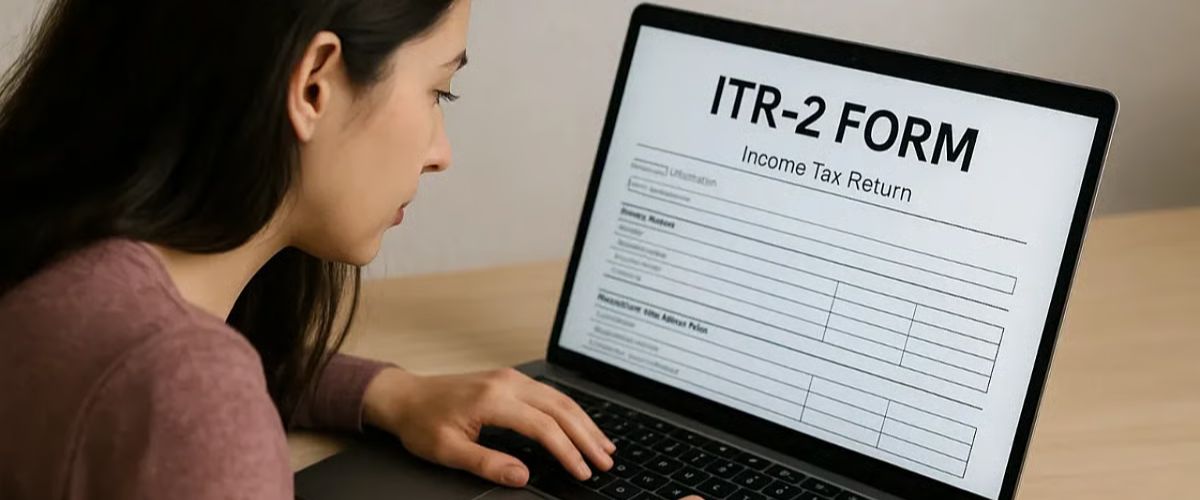


The Income Tax Department has introduced a significant upgrade for taxpayers with diversified income streams by rolling out a fully online, pre-filled ITR-2 form for Assessment Year (AY) 2025-26. This new feature is expected to simplify the tax filing process for millions of individuals who previously struggled with the complexity of filing returns, especially those with capital gains, multiple property holdings, or foreign assets.
By making ITR-2 completely online with pre-filled data, the department has eliminated the need for cumbersome offline utilities and JSON file uploads, which were previously a major source of confusion for non-technical users. This move not only saves time but also reduces errors, making tax compliance smoother and faster.
Before this upgrade, taxpayers who were required to file ITR-2 had to:
Download Excel or Java-based utilities from the Income Tax e-filing portal.
Fill in various income details manually, including salary, interest income, capital gains, and deductions.
Generate a JSON file, which then needed to be uploaded to the portal for final submission.
This offline method was time-consuming and prone to mistakes, often requiring help from tax professionals even for simple filings. For many salaried individuals with additional income from investments, the process felt unnecessarily complicated.
With the new system, taxpayers can log into the e-filing portal and find pre-filled ITR-2 forms that automatically fetch data from various sources, such as:
Employers (via Form 16 and TDS returns).
Banks and post offices (for interest income).
Mutual funds, brokers, and depositories (for capital gains).
This automation reduces the effort required by the taxpayer to fill in details manually and helps ensure that the data is consistent with what has been reported by third parties to the tax department.
The ITR-2 form is designed for individuals and Hindu Undivided Families (HUFs) who do not have income from business or profession but may have complex financial situations. Eligible taxpayers include those who have:
Income from salary or pension.
Income from more than one residential property.
Capital gains from the sale of shares, mutual funds, or property.
Foreign income or foreign assets.
Income from other sources such as interest, dividends, or winnings from lotteries.
Who cannot use ITR-2?
Business owners, self-employed professionals, and freelancers must continue to use ITR-3, which still requires offline preparation and JSON upload.
Individuals with simpler financial situations (such as a single salary income and no capital gains) can use ITR-1 (Sahaj) instead.
With the fully online form, taxpayers no longer need to download utilities or manually generate JSON files. Everything can be completed and submitted directly on the e-filing portal.
Pre-filling of essential details like salary, interest income, and TDS cuts down manual data entry. Many taxpayers can now file their returns in under 30 minutes compared to several hours previously.
Manual data entry was a major cause of filing errors and mismatches with the tax department's records. Pre-filled data sourced directly from employers, banks, and investment platforms ensures accuracy, reducing the risk of receiving notices or having to file revised returns.
Even individuals with minimal technical skills can now file returns independently without hiring professionals, saving both time and costs.
One of the most challenging aspects for investors was calculating and reporting capital gains from mutual funds and shares. With the new auto-fill feature, details of capital gains (as reported by depositories and fund houses) are pre-populated in the ITR-2 form.
Acknowledging the delay in rolling out the new ITR utilities, the government has extended the tax filing deadline for individual taxpayers from July 31, 2025, to September 15, 2025.
This extension gives taxpayers additional time to:
Review and verify their pre-filled data.
Report any discrepancies between the auto-populated data and their own records.
Get familiar with the new online filing interface before submitting their returns.
Taxpayers can follow these steps to file their returns:
Login to the Income Tax e-filing portal.
Navigate to “e-File” > “Income Tax Return” and select ITR-2 for AY 2025-26.
Review the auto-populated fields under income, TDS, and capital gains sections.
Enter any additional information (like deductions under Section 80C or 80D).
Validate the return and submit directly online using Aadhaar OTP or digital signature.
Tax experts have lauded this step as part of the government’s broader push toward a digital-first tax ecosystem.
According to tax consultants, pre-filled forms reduce reliance on third-party services for simple and moderate filings.
It also enhances transparency by showing taxpayers exactly what data is being reported by banks, employers, and financial institutions.
While the ITR-2 upgrade is a significant milestone, taxpayers using ITR-3 (for business or professional income) still face the challenge of manual preparation and JSON uploads. The Income Tax Department is expected to launch a similar pre-filled online feature for ITR-3 in the near future, making tax filing easier for self-employed individuals and small businesses.
The main advantage is that key income and TDS details are automatically populated, saving time and reducing errors.
No. Business owners and freelancers must use ITR-3.
Yes. Taxpayers can review and modify any pre-filled data before submission.
You can manually add any missing information before filing.
The deadline for individuals has been extended to September 15, 2025.
The launch of the pre-filled, fully online ITR-2 marks a significant leap forward in simplifying India’s tax filing system. Salaried professionals and investors can now save time, avoid technical challenges, and ensure error-free filings without the need for complex offline tools. With an extended deadline and seamless integration of data from multiple financial sources, this reform reflects the government’s ongoing efforts to make compliance simpler, faster, and more transparent.
Have questions about tax filing or financial compliance? Share your thoughts, and let our experts guide you with accurate and reliable advice.
Try it Risk Free we Don’t Charge Cancellation Fees.


Post By : CA Madhur
Jul 21, 2025